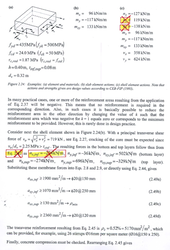
The other day I spent some time looking into a new numerical design method for reinforced concrete shell structures. This area was the focus of my master’s thesis and I’ve spent a good bit of time in this area since. I decided to implement this new method in Python so I could make some comparisons with the other methods I’m more familiar with.
The numerical technique is presented in a report from a major international technical society and is aimed at communicating how to apply this approach to practicing structural engineers (i.e. not academics with advanced mechanics and numerical methods training). The report presents the method as well as a basic design example. I decided to use their design example to validate my code and then use it for some numerical experiments of my own.
The problem? Errors. Their design example included two notation typos, an incorrect (and actually very misleading) equation reference, and a wrong calculation – all of this on one page (see above
I don’t expect a report like this to hold my hand. I have no problem working out the theory on my own and enjoy doing so. But if you are technical society providing a design example that practicing design engineers will use to test their comprehension of a new technique, you really need to make sure that you get it exactly right.
Why? Because structural engineers are going to design buildings using that method! (A building I might enter one day!)
Errors like these clearly damage the credibility of the technical society. I have only attempted to recreate one example from this technical report, but because of so many problems in one example, I have now significantly lost faith in the quality of this document. Has the rest of the document has been carefully checked?
I do understand that the editing process is complicated on multi-author technical reports, and I know of typos in my own documents. But let’s keep in mind that there is much at stake in practice-oriented documents. This isn’t an academic exercise anymore – we’re talking about real buildings where people live, work, and play.
-
I intentionally reduced the scan resolution so it can’t be identified. ↩